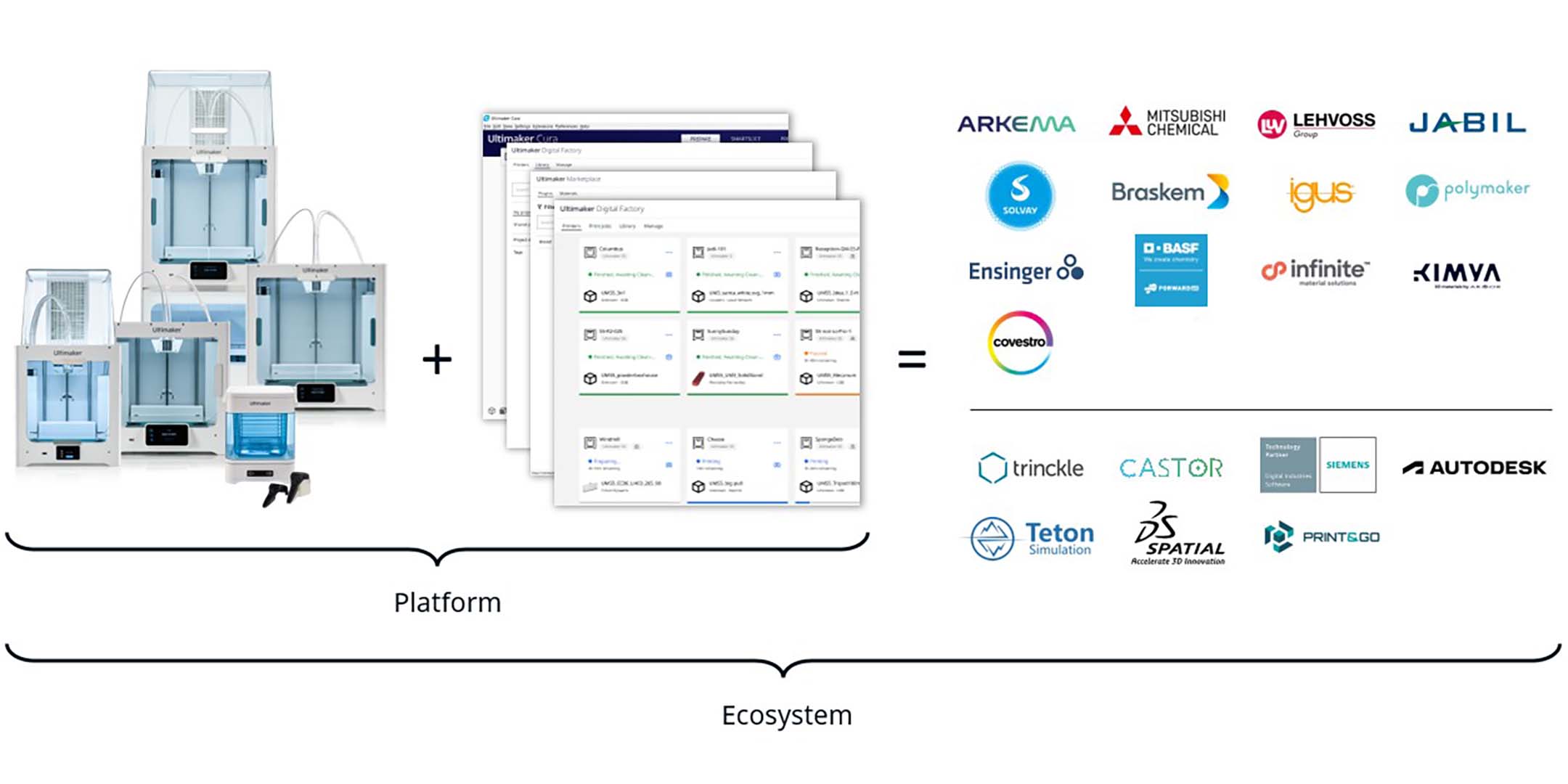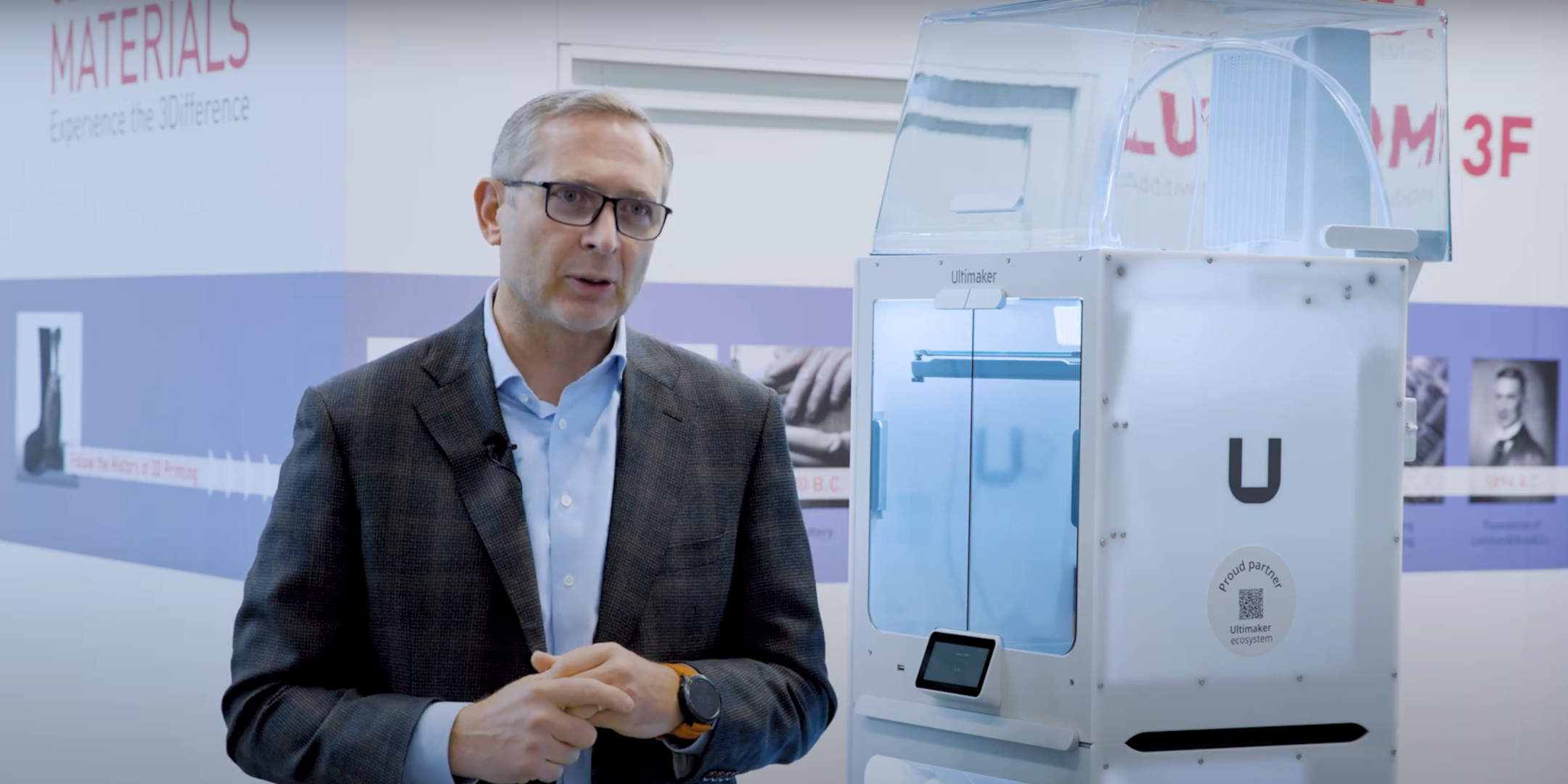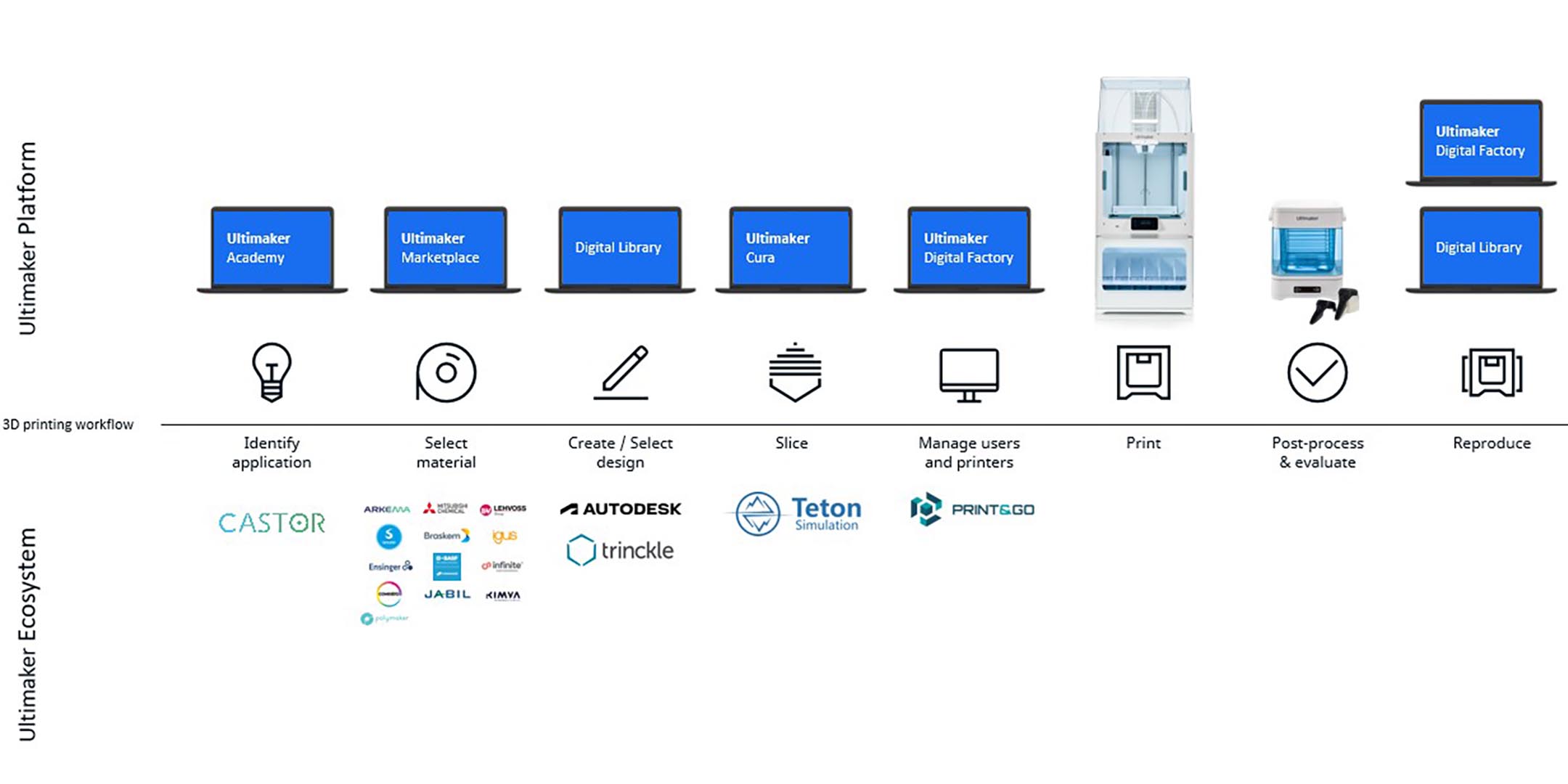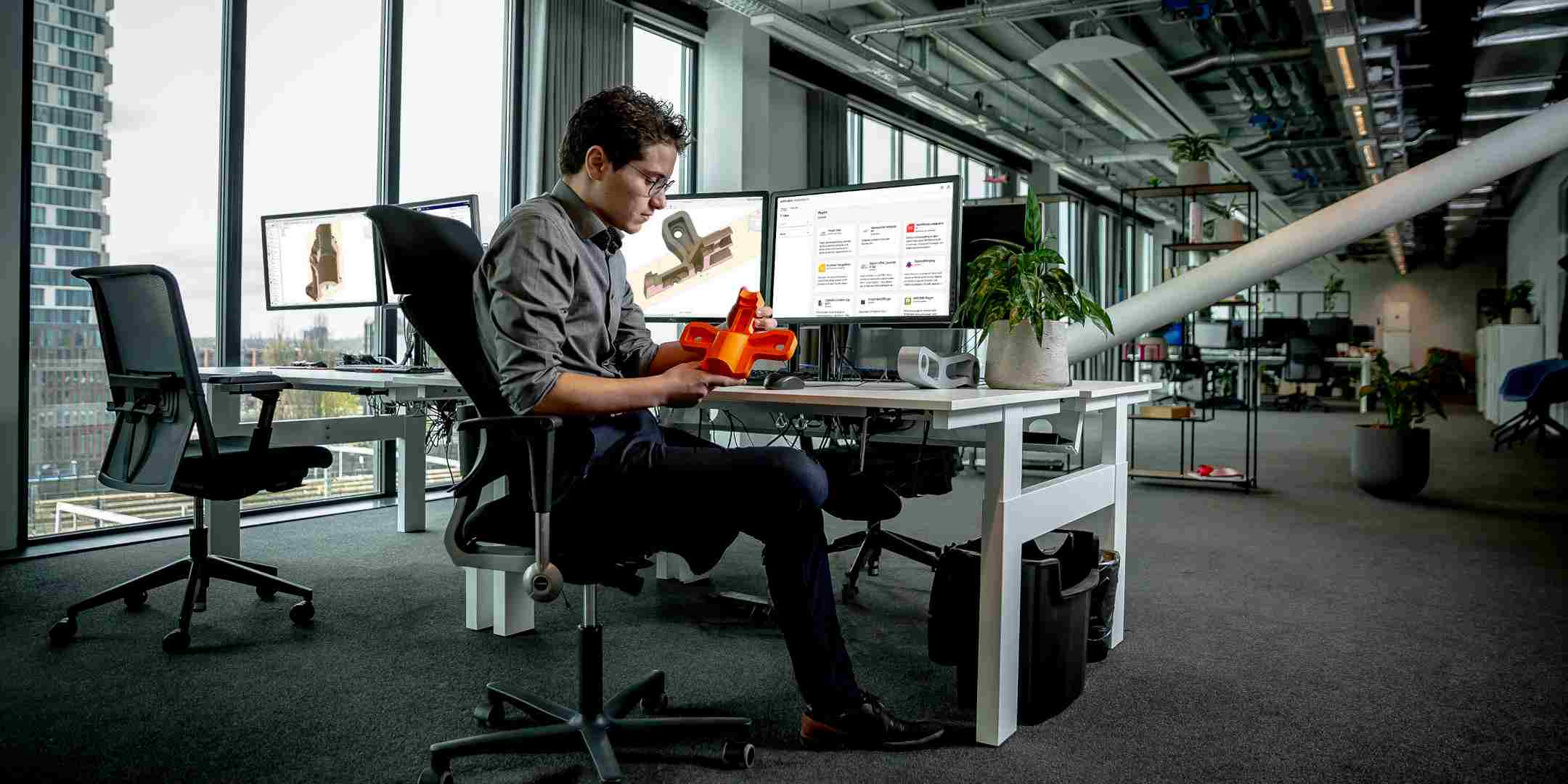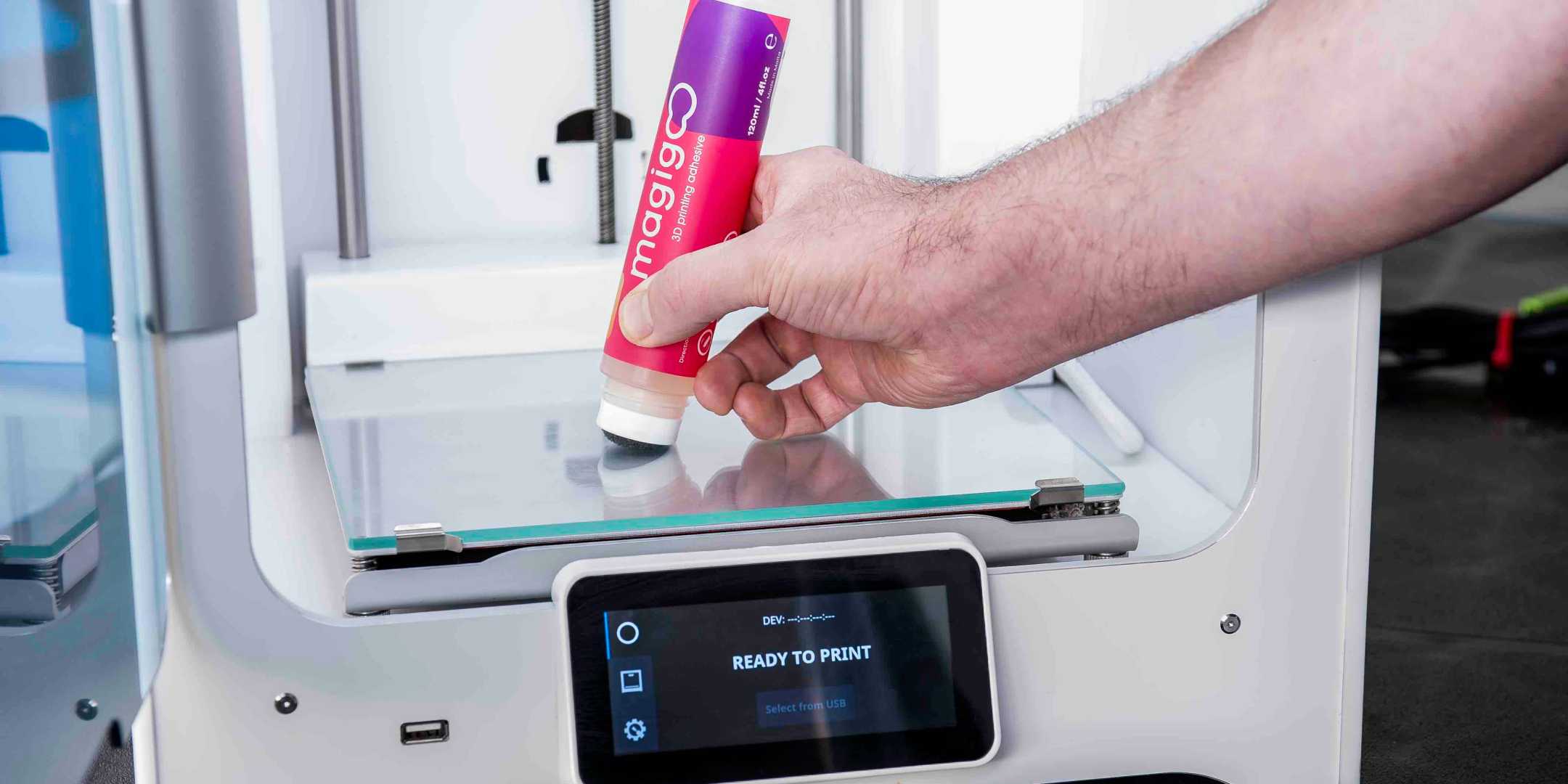A 3D printer doesn’t exist in isolation. Every user brings their own workflow and application needs, which means the 3D printer works best if it is compatible with specialist software tools and a diverse range of materials. In other words, an “ecosystem.”
So how do you create a 3D printing ecosystem without adding layers of complexity and obstacles regarding compatibility? And what are the advantages of such an ecosystem?
The ecosystem explained
We believe that what you can do with the Ultimaker platform can be taken to another level. Access to our hardware, software, and materials processes are also made available to our trusted partners – delivering a seamless, innovative, and future-proof customer experience.
Ultimaker products offer integrations with hundreds of 3rd-party materials and software tools – all designed to increase possibilities and save you time
Our third-party ecosystem is built upon the Ultimaker 3D printing platform, which consists of hardware, software, materials, and expertise. In each category, we have worked to create open, integrated methods of collaboration, from forming material partnerships with some of the world’s top producers of 3D printing filament, to APIs with partner software such as Autodesk Fusion 360, to expert support.
We want every step of your 3D printing workflow to be as convenient and simple as you imagine it to be – a custom fit. The above infographic shows in more detail the steps we take to ensure our users’ seamless navigation through each step of their 3D printing process, and in each pillar of the Ultimaker 3D printing ecosystem.
The Ultimaker ecosystem’s advantage is that it is not just an open invitation, but it is forged from strong, collaborative relationships with our partners, enabling a seamless connection between all the products and services within it.
“Customers are looking for solutions, not just a single technology or product,” Juergen von Hollen, Ultimaker CEO, says in the above video clip. “From that aspect, we need an ecosystem to help us develop specific, customized solutions.”
By combining the strengths of many companies, our ecosystem is able to develop just that – simultaneously creating a competitive advantage for our end users, through materials, hardware, software – or any combination of the three. It’s a win-win for all involved.
Let’s now take a look at the key areas of the Ultimaker ecosystem.
How Ultimaker products and our ecosystem can be used across the 3D printing workflow
A software solution for every use case
With software, we strive to understand the challenges or obstacles that our customers may face, then invite an ecosystem partner able to provide a tool as a solution. This way, our users will never need to hop from software provider to software provider to accomplish their goals. Instead, they’ll have everything they need for the entire 3D printing workflow under one roof.
Autodesk’s Fusion 360, for example, offers a full end-to-end CAD platform, offering granular control over setup, support materials, orientation, slicing, and the creation of STL or 3MF files for printing.
CASTOR’s part identification software assists users in solving the initial problem of finding the right parts to 3D print– from both a technical and economic standpoint – by analyzing CAD files and providing feedback on a part-by-part basis.
Meanwhile, Teton Simulation’s SmartSlice integrates directly into your slicer software, minimizing print time and material use while helping ensure that a final part won’t break. Using the software, you can optimize slicing parameters and virtually validate them – without even turning on your 3D printer.
The Ultimaker ecosystem also offers solutions for those not using hardware on the Ultimaker platform: 3D printers from other brands. PrintAndGo’s modular solution enables you to control a multi-brand 3D printing fleet, with functions such as printer management, file repositories, push notifications, and streaming.
Want to learn more about how the Ultimaker ecosystem enables and maximizes the efficacy and efficiency of 3D printing software? Watch our webinar on tech stack tools.
Integrations like CAD plugins and 3rd-party material printing profiles unlock more 3D printing possibilities
All about materials – from metal to motion
By providing users with the materials they need to create parts with specific properties that are built for industry use, the Ultimaker ecosystem further solidifies itself as a provider a full-service 3D printing workflow.
Take LEHVOSS Group’s LUVOCOM 3F PAHT® 9825 NT, a high-temperature polyamide-based material that exhibits the strength of a PA6 without sacrificing printability – and Ultimaker’s first Certified Material. Its unique properties are optimized for industrial 3D printing, and help users create high-quality end-use parts.
Igus’ high-performance polymers, known as motion plastics®, help reduce costs by lowering energy consumption in production and operation, and eliminating the use of lubricants. Its wear-resistant iglidur® I150 Tribofilament, which is certified on the Ultimaker ecosystem, is developed for use as bearing material and for wear parts. Its ease of use and high abrasion resistance make it a go-to material for applications with movement and friction.
And with BASF Forward AM’s Ultrafuse 316L and Ultrafuse 17-4PH filaments, our users can transform 3D printed geometries with an industry-standard debinding and sintering process to create solid metal parts. This solution enables easy, cost-efficient, and safe metal 3D printing – and helps the Ultimaker ecosystem cover an even broader area of potential customer needs.
Heading towards hardware
We are proud of what we have accomplished so far in establishing software and materials within the Ultimaker ecosystem – and we plan to continue innovating and evolving in those areas.
We plan to do the same with hardware and hardware add-ons, for an end-to-end solution. So far, our partnership with E3D, which provides high-quality, reliable extrusion systems and components, has helped us improve the robustness and lifetime of our print core CC.
We are also able to help improve first-layer adhesion by collaborating with Thought3D, which provides products and services key to reliable additive manufacturing – such as Magigoo adhesive for different material properties.
Our goal for the near future is to extend the range and variation of hardware partners, pushing boundaries, providing more options and possibilities for end-to-end solutions – and, of course, always innovating.
Collaborating with hardware and accessory suppliers is the next step in expanding Ultimaker’s integrated ecosystem
A flexible, sustainable future
For 3D printing to truly succeed, we believe it must offer users a seamless experience that is flexible and holds sustainable value. We also believe that additive manufacturing technology should continuously improve, proactively manage risks, and understand investment and business case criteria.
The Ultimaker ecosystem achieves this, evolving along with the industry and its users. It is symbiotic, collaborative, and open, with the goal of not just improving and furthering our organization, but the 3D printing industry as a whole.
The advancement of the industry is central to Ultimaker’s values, where openness and involvements have been embedded into our organizational DNA since the very beginning. It’s an industry we love, that we are passionate about – and that we believe in.
And we’re excited to see what comes next.
Want to learn more about the Ultimaker ecosystem and our partners within it?















